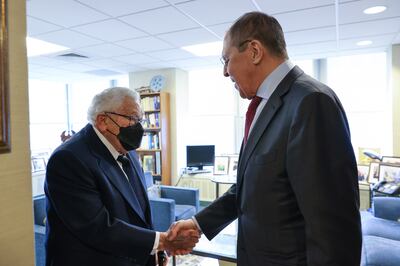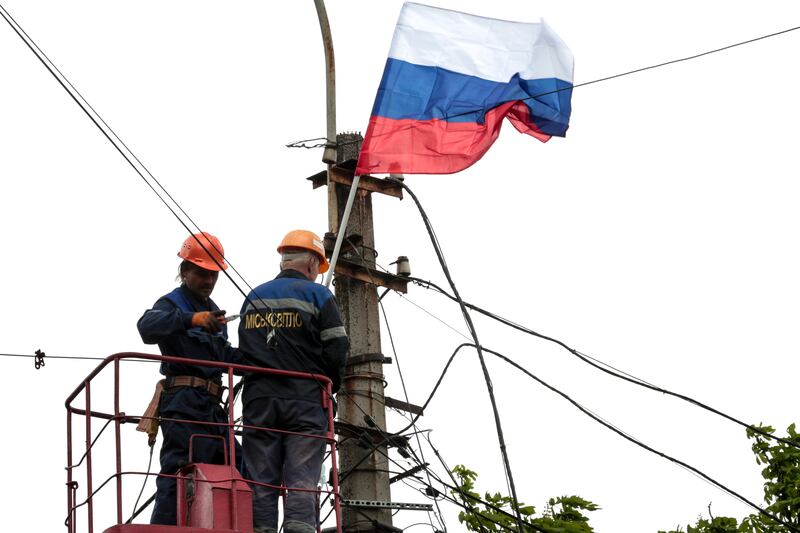The question preoccupying Europe is whether Russia is on the brink of a surprise breakthrough on the Ukraine battlefield, allowing it to declare a victory on its own terms. The big issue, were this to materialise, is to ask what then?
The artillery battles across the Donbas have recently been going well for the Russian high command. A traditional attack plan has been prosecuted, involving tactics that Russia has favoured for almost century. The original presumptions of Russian President Vladimir Putin's leadership are now within its sights.
Having annexed Crimea and sustained the two breakaway republics of Donetsk and Luhansk since the first round of this conflict in 2014, Moscow wants a contiguous strip of south-eastern Ukraine to say that it has secured the future of the Russian-speaking population in the area.
It has also overcome and vanquished the resistance of the neo-Nazi-tainted Azov Battalion after weeks of resistance to a Russian onslaught in Mariupol, the port city on the Black Sea. That means that the Kremlin’s “denazification” justification for the assault on Ukraine – it said the spectre of Nazism had risen in the country – can also be defined as a success.
Any such victory declaration would be viewed from several angles.
The western countries that backed Kyiv would be forced to confront the fear that they had not in the end done enough for their ally to withstand the Russia tempest. Yet, for Russia having drawn the broadest aim for its offensive, the resulting gains look awfully puny on a map.
Faced with this, allies of Ukraine are stepping up the weapons shipments. The shoulder-fired missile systems that proved so effective when Russia’s army was advancing in columns and could be picked off are not the game changer they once were.
Ukrainian forces are only now getting access to mobile artillery. The French Caesar howitzer gun has turned up on the battlefield and offered a tantalising glimpse of what bulk deliveries could do. The US has been trying to get M777-towed 155-millimetre howitzers to Ukraine's frontline for a month.
The German government is being criticised for not enabling the next step, which is the delivery of main battle tanks. The Ukrainian military desperately needs these to meet the mass of forces that Russia is bringing to bear in a relatively small section of terrain.
Last week, UK Prime Minister Boris Johnson called for the delivery of M270 multiple launch rocket systems, or MLRS, to Ukraine after receiving a downbeat assessment from President Volodymyr Zelenskyy regarding how long Kyiv’s forces can hold out in the eastern region.
The introduction of this system has escalatory potential. Reports that US officials opened talks with Kyiv over placing limits on the range of outgoing fire for any donations Washington might make underline this. The MLRS can target as far away as 300 kilometres but the US cannot allow its guns to be striking inside Russia.
Russian Foreign Minister Sergey Lavrov came out to warn that the “few sane” minds in the West should think twice.
Intelligence reporting indicates that Russia has lost 1,000 of the tanks it sent to Ukraine. Its new-generation tanks have proved to be sitting ducks.
So it has removed from mothballs the hundreds of T-72s left over from the erstwhile Soviet Union's Red Army. Pictures of its heavy fire power are telling. Iron armour will now have to do the job that was not done by the smart or next-generation technology that Russia gambled on.

Days before the war was launched, a western think tank expert predicted to me that Russia would not rush to war because the modernisation of its armed forces was incomplete. To do so now would be to “waste” the heavy expenditure since 2012 under the New Look reform programme, the expert said. He pointed out that Russia's army could only say that its pace of change was well behind the target of renewing 70 per cent of its equipment inventory by 2020. It is believed to have been hovering near 50 per cent when the war began.
Western officials view any move by Russia to draw a line north of Crimea and along to Donetsk and Luhansk as unsustainable peace. Not only would Russia have an iron hand on the export of Ukraine’s all-important crops as a result. It is not clear that the boundaries it is currently targeting would guarantee the water supply to Crimea, a key Moscow objective.
Yet, this is the type of outcome Henry Kissinger, the realist diplomatic thinker and former US secretary of state, argued for last week in his controversial intervention in Davos. Mr Kissinger argued about two things: that Ukraine cede territory to Russia for a peace agreement, and that a humiliating defeat for Russia would endanger Europe's stability.
Currently serving European officials, instead, argue that a peace deal would be more likely to kick off a new eight-year cycle of rearmament by Moscow. The inevitable result would be a renewed effort thereafter to carve up Ukraine. In such an atmosphere, and with global food shortages, there can be no reliable turning point in the confrontation.
If Russia is able to achieve a short-term comeback, the outcome looks likely to merely open the next phase of a deeply destabilising situation.





